Michigan hop scouting report for June 10, 2015
Downy mildew continues to be a problem for growers, with difficult spray weather and weed control issues likely contributing to the problem. Potato leafhopper are present in significant numbers and twospotted spider mites are visible at low levels.

Northwest Michigan summary
Hop bines in the north continue to grow quickly with some varieties already 10 feet up the string. Numerous downy mildew spikes and secondary leaf infections are present with severely infected or highly susceptible plants collapsing completely in some cases. Infected bines that were unknowingly trained earlier this season are failing to climb the string. Yards that did not have good early season weed control are really struggling to suppress large, established weeds in the row which is exacerbating the downy mildew problem. Weeds can prevent good fungicide coverage and increase drying time around the crown. Early herbicide applications when weeds are small are critical to season-long suppression. Growers may also consider using dormant preemergent herbicides in the future.
Potato leafhopper numbers have risen quickly over the past week and twospotted spider mite are being seen in low numbers. Irrigation and fertigation systems are up and running. Bines are trained with many growers revisiting trained yards to correct bine number and retrain as needed.
Southwest Michigan summary
Bine growth will continue for a couple more weeks; mature hops will have that time to fill out the trellis. Downy mildew continues to develop on many hops in the area, including spiking in shoots and leaf infection. In hopyards scouted by Michigan State University Extension, potato leafhopper pressure has still been light this season. As leafhoppers proliferate, insecticide sprays may become necessary to manage them. However, pyrethroid applications will damage predator mite populations and cause outbreaks of twospotted spider mites. In any case, growers should also be scouting for twospotted spider mite in the coming weeks.
Hopyards in the southwest are all strung and trained by now. Irrigation and continuing drip nitrogen (N) applications in the coming week will help push more bine growth, except on poorly-drained sites.
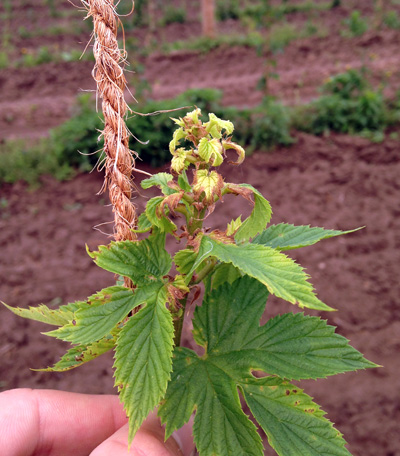
Downy mildew shoot spike, June 9, 2015. Photo credit: Brad Baughman, MSU Extension
Statewide report
Growing degree day (GDD) accumulation and rainfall summary | |||
|---|---|---|---|
|
Location |
GDD45 |
GDD50 |
Rain (inches) |
|
Traverse City |
637 |
425 |
0.6 |
|
Clarksville |
781 |
537 |
0.17 |
|
Romeo |
872 |
610 |
1.24 |
|
Benton Harbor |
888 |
621 |
0.27 |
Wet and humid conditions last fall and this spring have provided ideal conditions for downy mildew to become a problem in Michigan hopyards. All hopyards, even new yards not exhibiting signs or symptoms of downy mildew, should be utilizing a season-long (from 6-inch bines through harvest) protectant fungicide program to minimize downy mildew infection. Even when growers follow best management practices, downy mildew can be a problem. The severity of downy mildew is increased by high disease pressure from previous outbreaks, conducive environmental conditions, poor fungicide timing, suboptimal spray coverage, fungicide wash-off, cultivar susceptibility or a combination of factors.
In addition, fungicide resistance may play a role in some cases. Growers who were able to apply fungicide treatments on a protectant basis ahead of recent rain events are seeing lower infection levels, but still experiencing significant pressure for this time of the season. For more information about downy mildew biology and management, refer to “Management Options for hopyards with downy mildew” from MSU Extension.
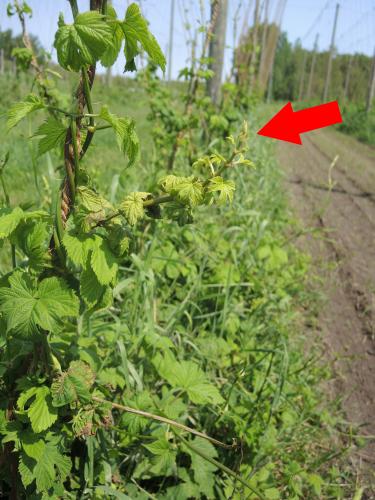
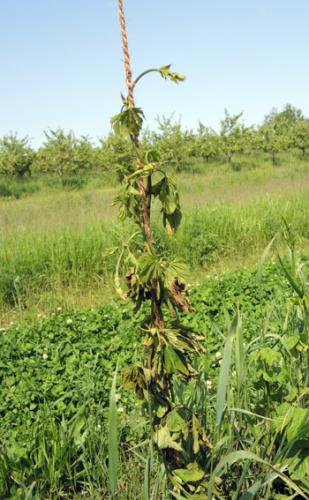
Left, Hop bine systemically infected with downy mildew falling off the coir and failing to climb the string. Right, Hop plant systemically infected with downy mildew collapsing on the coir. Photo credits: Erin Lizotte, MSU Extension
With significant leaf tissue present, growers should be scouting for twospotted spider mites, which are present in low numbers. Twospotted spider mites are a significant pest of hops in Michigan and can cause complete economic crop loss when high numbers occur. Twospotted spider mites decrease the photosynthetic ability of the leaves, cause direct mechanical damage to hop cones and act as a contaminate pest in harvested cones. They feed on the liquid in plant cells, eventually causing visible symptoms. Leaves take on a white appearance and will eventually defoliate under high pressure conditions. Intense infestations weaken the plant and reduce yield and quality. Infested cones develop a reddish discoloration, do not hold up to the drying process, and commonly have lower alpha levels and shorter storage potential.
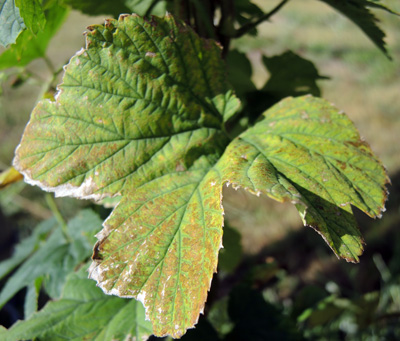
Damage to hop leaves caused by twospotted spider mite feeding.
In the spring, only female twospotted spider mites are present. After they mate, females overwinter in a dormant stage on debris and trellis structures. They emerge in the spring already mated and ready to lay fertilized eggs, often appearing particularly orange in color this time of year. As the temperature warms, the females feed and begin laying eggs. Larvae emerge from the eggs in two to five days, depending on temperature, and develop into adults in one to three weeks, again depending on temperature. Twospotted spider mites like it hot with the pace of development increasing until an upper threshold around 100 degrees Fahrenheit is reached. Conversely, cold and wet weather slows down their development.
Twospotted spider mites are very small but can be observed on the underside of leaves using a hand lens. As the season progresses, cast skins and old webbing give infested leaves a dusty and dirty appearance. The eggs look like tiny, clear spheres and are most commonly found in close proximity to adults and larvae. The larvae themselves are small, translucent versions of the adults which begin the season with a distinctly orange hue that changes over to translucent, yellow or green as they feed. Adults also have two distinctive dark spots, hence the name.
When you are observing the underside of leaves, keep an eye out for beneficial predatory mites that actually feed on twospotted spider mites. Predatory mites are often translucent, larger than twospotted spider mites and move at a much faster speed across the leaf surface. Predatory mites play an important role in balancing the twospotted spider mite population and should be protected when possible by avoiding the use of broad spectrum insecticides. Refer to pages 11-12 of “Pesticides registered for use on hop in Michigan 2015” for more information about impacts of pesticides on beneficial mites.
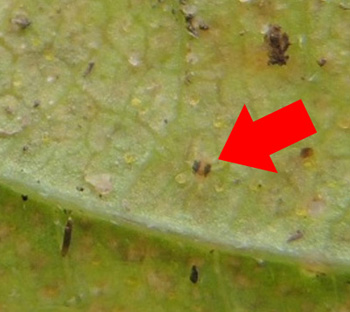
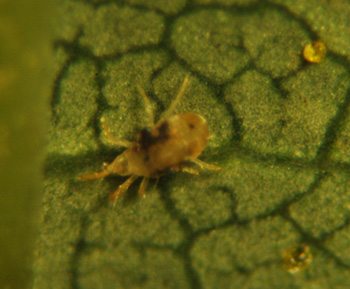
Twospotted spider mites as seen with the naked eye and under magnification. Note the sand and cast skins collecting on the webbing associated with the mites, giving the leaves a dusty appearance.
Growers should also continue to evaluate the prevalence of potato leafhoppers in hopyards. Storm systems that moved through over the last few weeks have carried adults from the Gulf Region and populations around the state have increased substantially over the past week as the adults have begun reproducing locally. Potato leafhoppers move in all directions when disturbed, unlike some leafhoppers that have a distinct pattern of movement. Adults and nymphs appear a fluorescent green color. Some very small nymphs are actually clear, but have the characteristic shape of the larger nymphs when viewed using a hand lens.
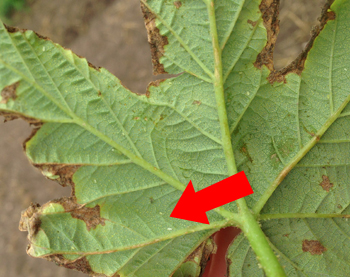
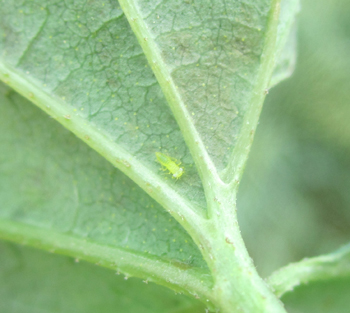
Left, multiple potato leafhopper nymphs and adults on the underside of a hop leaf exhibiting necrotic “hopper burn” symptoms around the leaf margin. Right, potato leafhopper nymph under magnification.
Although hop plants are susceptible to potato leafhoppers, they can tolerate some level of feeding, and growers should be conservative in the application of insecticides. Potato leafhoppers causes what growers have termed “hopper burn,” which causes necrosis of the leaf margin in a v-shaped pattern and may cause a yellowed or stunted appearance as well. When hops bines are shaken quickly, adults will take flight. Growers can go through and shake bines and look for flying adults as a quick spot check. Confirm their presence by flipping leaves over and looking for adults and wingless nymphs on the undersides.
Growers needing to treat for PLH can utilize labeled products containing neonicotinoids (IRAC group 4A, e.g., thiamethoxam and imidacloprid), pyrethroids (e.g., beta-cyfluthrin, bifenthrin and pyrethrin), organophosphates (group 1B, e.g., malathion), tetramic acid derivatives (group 23, e.g., spirotetramat) or spinosyns (group 5, e.g., spinosad). Organic growers can utilize spinosad or pyrethrin formulations that are OMRI-approved for PLH management. For a complete list of registered products and the chemical class to which they belong, see “Pesticides registered for use on hop in Michigan 2015.” Refer to pages 11-12 to determine which products will have the least negative impact on important beneficial insects like predatory mites.



 Print
Print Email
Email




